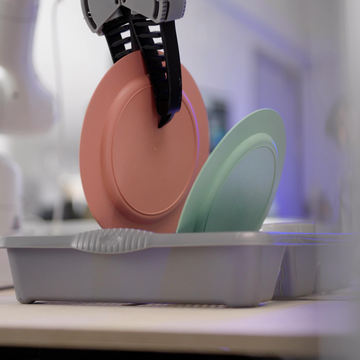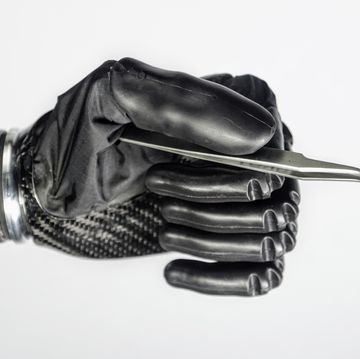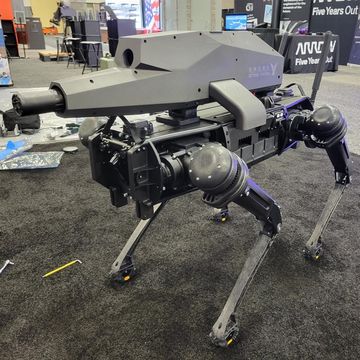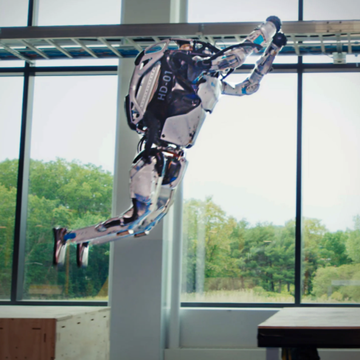The mansion sits in a clearing amid old-growth trees, a gorgeous home at the end of a long driveway off a shaded street off a winding road. Farmhouses dating to the Revolutionary War sit at the edge of hilly meadows. The roboticist strolls across the lawn wearing a simple blue dress, the lush grass cool under her bare feet. Her black hair hangs below her shoulders, and she waves as she walks through the metal gate that separates the sprawling front lawn from the swimming pool behind the house.
"Beautiful, isn't it?"
She extends a hand and shakes hard.
"Oh, this isn't mine," she says, waving at the grounds and tucking her hair behind her ear. She has tan skin and high cheekbones, almond eyes and a sleek smile, and the strong voice of a busy mother. "It belongs to one of my investors. They just let us work here."
Cynthia Breazeal is an associate professor at Massachusetts Institute of Technology, in Cambridge, and the founder of the Personal Robots Group at the MIT Media Lab. She is one of the world's leading pioneers in the field of social robotics, which essentially is the science of making robots act more like humans. She has been working for two years on a product called Jibo, a machine she describes as a family robot because she envisions a day when every household will have one on the kitchen counter, playing an active and cheerful role in not only managing daily life but in making it better. Earlier this year Breazeal launched a campaign on the crowdfunding site Indiegogo to raise awareness of Jibo and to help fund her company, Jibo, Inc. She set a goal of $100,000. In two months donors gave her a total of $2,228,409.
The pool house behind the mansion—Jibo, Inc.'s satellite office—could accommodate a small family. It's quiet here, free of the distractions of Cambridge, and Breazeal and her team can work in focused solitude. More than 4,800 Jibos have been preordered, and Breazeal has promised to start shipping in late 2015—just under a year from now.
In the pool house two Jibo employees sit in overstuffed chairs in front of large windows, laptops in laps. A man wearing a Jibo T-shirt cleans off the granite countertop of the small kitchen. "This is actually where we shot a lot of the scenes in the Indiegogo video," Breazeal says. In that video you see Jibo taking photos of a large family at a birthday party. You see it greeting a single guy coming home from work, asking if he'd like for Jibo to order Chinese takeout. It reads a story to a little girl at bedtime, acting it out in different voices. It reminds a woman who's baking a pie that her friend will soon arrive to take her grocery shopping.
"And it does all those things without you having to keep reaching into your pocket to pull out a phone," Breazeal says. "It's just there for you, all the time."
The utopian households in the promotional video are a little over the top, and some members of the gadget-watching cognoscenti have called Jibo weird, creepy, unnecessary, a silly attempt to alter the course of human existence that actually just takes pictures and tells you when you have a phone call. The consumer-technology landscape is a battlefield. New products are picked apart as soon as they're announced, with every pixel and micron getting parsed and analyzed and naysayed by experts. The thing with Jibo is, because Jibo, Inc. is not Apple, Breazeal has had to make her efforts public long before there is a product to buy—long before her product is anything close to the way she wants it. And not all the experts seem to understand the way she wants it.
Breazeal, 46, is a mother of three, ages 9, 8, and 6. She likes to say that she's never in any photographs of her family because she's always behind the camera. That everyday mother's lament is not exactly what drove her to create Jibo, but it's not insignificant to the robot's genesis. She wants Jibo to be a friendly presence in the house to fix little problems like that one, because fixing little problems can make a moment better, and moments are what make up a life.
A white Jibo prototype sits on the counter.
She asks the man in the T-shirt, "Okay?"
"Yeah," he says.
Breazeal stands a few feet from Jibo and says, in a voice only slightly different from the one she uses to talk to humans, "Wake up, Jibo."
Nothing.
Breazeal looks at the man.
"Wait," he says, adjusting, fiddling. "Hold on. Okay. Go ahead."
Again Breazeal looks at her robot and says with purpose and hope, "Wake up, Jibo."
The robot's round head twists on its base, a remarkably human wiggle. A white circle appears on its round screen, like an eye opening. In a voice like an animated movie character—cute, cheerful, but not treacly or grating—Jibo responds, "Hello, Cynthia!"
A lot of people use the phrase robot servant when they talk about Jibo, alluding to some kind of Jetsons machine that brings you a drink when you get home. In a subsequent meeting with Breazeal, I make the mistake of repeating those words.
Up until this point things have been casual, a spirited conversation on a Friday afternoon back in her office at MIT. Breazeal is wearing a peach shirt, hair pulled to the side, and the sun is making her office glow, illuminating the Star Wars memorabilia, including the framed photo of her with George Lucas, and an R2-D2 in a large box. Star Wars was the movie that started her fascination with robots. She has been trying to make R2 real ever since.
But as she straightens up her office before the weekend, she is informed that an article has just been published on wired.com, a think piece that asks the question: Is a life lived with a robot servant the kind of life we want to live?
She sighs and says, "It's not living with a robot servant." She sounds exasperated and annoyed, like a mother telling her child for the 11th time to please get his feet off the seat. "Calling it a servant just automatically puts it in a very old-fashioned bucket of the robot servant of the 1960s." She speaks more loudly and animatedly, having left her office and now walking down the open stairwell inside the atrium of the Media Lab, squeezing past colleagues in this bizarre hub of innovation that looks like Willy Wonka's Chocolate Factory for the TED generation. "That's like the unmodern view of what this and so many other things are about." At the bottom of the stairs she stops and laughs at herself a little for getting worked up. "Anyway."
Criticism is largely new territory for Breazeal. She's had a long and distinguished career in robotics at MIT, first in the Artificial Intelligence Lab, and, since 2001, in the Media Lab's Personal Robots Group. But for the first time Breazeal isn't just showing the world something cool. She is selling it.
With Jibo she has had to step out of the lab and answer questions. The first, which I ask when she calms down—following more shouts of "completely wrong" and "totally uninspired"—is the most obvious for anyone selling a gadget: Why do I need it?
Breazeal gestures emphatically at the smartphone I'm carrying. "One of my pet peeves about technology is, these are individual devices," she says. "When you have a technology that's designed for an individual, what do you get? You get whole families sitting around the dinner table with their face in their device, pushing away and excluding the other people. I have three boys, and they love these damn things, and they pick them up and they stick their faces in it, and they walk off, and I'm like, 'Sweetheart, I am still talking to you.' "
Jibo, she says, is not an individual device but a family device. "It's the first kind of technology that allows you to stay in your life, in the real world, in the moment, rather than say, 'I've got to stop what I'm doing, I've got to find my device, I've got to pick it up, I've got to enter my code, I've got to open the app—and then I can go back to my life.' That's what our relationship with technology is today."
Social robots are not a tool, she argues. They are a partner. Tools force you to leave the moment. Jibo, she argues, will allow you to access all that information and technology while you stay in the moment—while you stay in your life.
I rarely record interviews, but my right hand, the one I use to write, is in a cast today, so I'm using my smartphone as a digital recorder. The reason I avoid microphones and recorders and, worst of all, cameras, is that if you train one on a human, it inspires performance, a personal encounter outsourced to something or someone that is not actually present. As Breazeal makes her case for Jibo, something happens: She starts talking at my phone. She sounds like someone being interviewed rather than someone just talking. And this, perhaps above all else, is what Jibo eliminates. Like prayer for the devout, with Jibo the idea is that you do not feel like you're talking to yourself or even to a machine. You feel like you're talking to someone.
Seven years ago, not far from MIT, I was walking down the street, days into owning my first smartphone, when rain began to fall. I ducked under an awning to wait it out, and in a gesture so familiar now it's hard to believe it had meaning then, I reached into my pocket for my phone. As I swiped through the apps, still a new world of discovery back then—a digital Swiss Army knife—I came to realize that I was essentially looking for an umbrella. Something that would let me continue with my life despite the rain, or to pass the time, or to entertain me, or to accomplish a task.
Plus, waiting for the rain to stop is boring, and under that awning I also realized I would never be bored again.
That kind of before-and-after moment is what Breazeal hopes for when Jibo becomes widely available. It won't be in your pocket. It will surround you. And you will talk to it. And it's a cute little cartoon of animated aluminum. If the smartphone was the end of boredom, Jibo promises to be the end of being alone.
Stand and Deliver
(Illustration by Brown Bird Design)
Jibo is stationary—but otherwise fully interactive. Here are the robot's vital stats.—
• About 11 inches tall, 6 pounds
• Body made of aluminum, plastic, and glass
• "Face" is a high-definition LCD touchscreen
• Two high-resolution cameras recognize and track faces, snap photos, and facilitate video
• 360-degree microphones and natural-language processing allow you to talk to the robot from anywhere in the room
• Can be connected to both Wi-Fi and Bluetooth
The machine itself is a 6-pound tabletop device, 11 inches tall, that looks like the love child of Kenny from South Park and the robot Eve from WALL-E—small, rounded, spritely, mischievous. There is a dark, 5.7-inch touchscreen where its face would be, and on it an orb that is remarkably adept at implying human facial expressions. Hidden away in the head are stereo speakers and microphones, as well as tracking cameras that will allow Jibo to identify and follow people around the room, observing and interpreting and offering suggestions if, say, it recognizes that you're cooking and your hands are dirty and your friend has just texted. Jibo is designed to take candid photos—the kind Breazeal says she is never in—at your command. For video chatting, the tracking function will allow the user on the other end to control what Jibo is looking at, permitting grandma to chase the grandkids around the house.
Jibo is in fact ideal for the elderly, Breazeal says, both for emergency communications and also for companionship itself. A few years ago I bought an iPad for my 85-year-old grandmother, who lives alone. As I did, I felt extreme guilt, as if I'd passed her off to a digital babysitter. But she now refers to the iPad as her boyfriend. For the first time since my grandfather died 16 years ago, she says it feels like there's someone waiting for her at home.
Jibo has just a few main body parts that allow all of this: a head and a swiveling torso, slightly offset on a pedestal base, and a three-axis motor system so that the interaction among the three can further convey human gestures—a knowing glance, a curious head tilt, the technology of emotion. Breazeal is big on gestures of emotion. She's the kind of person who hits you when she's making a point.
The emotion part, or the companionship part, is where cool can drift toward creepy. In that promotional video for Jibo, when it's reading a bedtime story to the little girl, the robot is expressive and engaging. (Jibo operates on a Linux-based platform, so developers can create apps and games that take advantage of that expressive delivery of information. Breazeal is also the codirector of MIT's Center for Future Storytelling.) But you can see how this is not a child listening to a book on tape or watching an interactive e-book or a movie. This is a child being read a story. Yes, the reader of the story is a computer. But to a child born in an age in which cars tell her parents when to turn left and her favorite cartoons can be streamed to the television at any time, this will not seem like a big deal at all.
Breazeal continues through MIT's campus, down the Infinite Corridor, past a couple of dozen students juggling in Lobby 10, then out onto Massachusetts Avenue, past the school's nuclear reactor, until we arrive at the MIT Museum. She is talking and making points and hitting me the entire time.
At the ticket counter Breazeal goes through a polite fumbling routine in which she pretends they won't know who she is.
"How does this work? I just show you my MIT ID?" Breazeal says. "I haven't been here in so long."
"Oh, you don't have to pay," a woman at the counter coos. (The woman will later say to me, "I was jealous that you got to go up there with her. She was stalling. She knew I knew who she was.") We ascend the stairs to the second floor and arrive at an exhibit entitled "Robots and Beyond: Exploring Artificial Intelligence at MIT." At the far end of the room, in a glass case, a robot called Kismet, the world's first robot capable of social interaction, waits for her like a taxidermy owl. As a postdoctoral fellow in the AI lab in the 1990s, Breazeal led the team that created it.
As we walk slowly and in unison—the museum walk—Breazeal glances at the other robots in the room, all of them groundbreaking, many of them with her handiwork inside them. She gives academic descriptions of each, all very interesting. But the flick of her eyes, the tilt of her body, is toward Kismet.
It looks like a head made from an Erector set, more gremlin than human, but even unplugged it has an eerie presence, as if it might start moving at any moment. It has big orange lips and paper ears, but it is the eyebrows and eyelashes around the richly detailed eyes that make the hair on the back of your neck stand up.
Breazeal spends a long, still minute looking at the assemblage of metal and wires. "It's the first," she says, softly, slowly. She looks like someone seeing a photograph of an old friend with whom she has fallen out of touch. "It's the first of its kind."
She is no longer talking to my smartphone.
"Kismet had a lot of charm. When you create something like a social robot, you can experience it on all these different levels. You can think about it from the science standpoint and the engineering standpoint, but you can experience it as a social other. And they're not in conflict. When Kismet would turn and look at you with its eyes, you felt like someone was at home. It was like, I feel like I'm talking to someone who is actually interpreting and responding and interacting with me in this connected way. I don't feel like it's a dead ghost of a shell. I actually feel the presence of Kismet."
We leave the museum and walk up Massachusetts Avenue toward Central Square so Breazeal can hop on the subway to her home in Harvard Square. All around us people are staring at their phones, listening on earbuds. Alone. Together.
What's scary about social robots—the human machine—is precisely what Breazeal argues is most human about them. This is the moment, she believes, historians will look back on and recognize as "the time when we appreciate that technology has to actually match how we experience and think and act and decide, so that we become more empowered. That's the shift: the humanization of technology to serve human values." It's the same kind of slightly terrifying optimism that made people call Alan Turing and Steve Jobs crazy, back before anyone knew whether their ambitious machines would actually work.
As she departs, Breazeal stops and takes one final shot at those two words: robot servant.
"That is so brain-dead," she says. "It just annoys me."
And then she smiles, and hits me.














